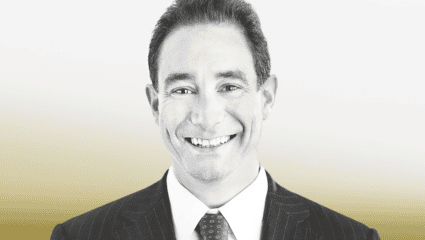Alexander Hamilton. Thomas Jefferson. P.T. Barnum. Herman Melville. Henry Ford. Charlie Chaplin. John Maynard Keynes. The city of Houston. All feature in “Ages of American Capitalism: A History of the United States,” a sprawling new book where Jonathan Levy integrates the country’s economic history into a broad political and cultural framework.
It’s an ambitious and often captivating work, and one in which Levy, a professor of history at the University of Chicago, admits at the outset that he committed the “sin,” at least for academic historians, of “having written a ‘presentist book,’ always with an eye on the extraordinary economic times in which we are living and what might come next in light of what has happened in the past,” a claim belied at least in part by the 110 pages of notes at the end of the volume.
The end notes testify to another of Levy’s goals in the book, an effort to synthesize the “new history of capitalism” that scholars have developed over the past generation in works that look beyond large companies and elite financial actors to explore, for example, the American slave economy as a sophisticated economic system, the development of industrial-scale agriculture in the late 19th century and the roots of big data in the insurance companies of the early 20th century.
Levy contributed to that enterprise with his first book, “Freaks of Fortune: The Emerging World of Capitalism and Risk in America,” a study of changing conceptions of risk in the 19th century. But, he writes at the start of “Ages of American Capitalism,” the scholarship needs to engage with economics, especially the work of thinkers such as Keynes, Thorstein Veblen and Joseph Schumpeter, not to mention Adam Smith and Karl Marx, all of whose perspectives he integrates into his new book.
Keynes looms especially large for Levy, who breaks the book into four sections, the “ages” of the title. The first, the Age of Commerce, starts in the colonial era, when the U.K. was attempting to turn its colonies in the Americas into a profitable enterprise. The success of that endeavor is the first example of a theme that recurs throughout the book. “For good and for ill,” Levy writes, “states have illustrated the capacity to orchestrate long-term economic development.”
Hamilton certainly believed in that possibility. His battle with Jefferson over the economic nature of the newly created U.S. would resonate throughout American history. Seeing Britain as a model, Hamilton believed that the creation of a permanent national debt was “a national blessing” because it would generate both currency and liquidity, which in turn would spur economic growth. Jefferson was suspicious of this path, which he thought would imperil the yeomen farmers whom he believed were the backbone of American democracy. But American creditworthiness in Europe “made possible by Hamilton’s fiscal system,” Levy writes, allowed Jefferson to finance the Louisiana purchase.
Many Americans shared Hamilton’s commercial orientation. In one of the book’s best chapters, Levy considers how Barnum, Melville and Henry David Thoreau responded to the capitalism of the 1840s and 1850s, a time when industrial production in the north was growing at 7.5% annually, “the greatest two-decade spurt of growth in U.S. industrial history,” Levy writes.
While Thoreau advocated individual disengagement with the economic world, Barnum became a rich man putting on spectacles that let the audience decide what was real and what was humbug. “Put on the appearance of business, and generally the reality will follow,” he wrote in his autobiography. Melville plumbed the implications of that statement in his novel “The Confidence-Man,” which in Levy’s reading becomes the great novel of commercial life. Trust the title character in one of his schemes and you may lose all your money; refuse to engage with him, and economic activity as well as social life come to a halt.
In the public sphere, this conundrum takes the form of the struggle over monetary policy, which is a central theme of the book. In the Panic of 1873, “More deflation was the solution to deflation, and more bankruptcy was the solution to bankruptcy — the solution that would echo through the Great Depression of the 1930s,” Levy writes. A cramped adherence to the gold standard and, more broadly, tight monetary policy, unduly limited the options economic policymakers had in times of crisis, as Federal Reserve chairman Ben Bernanke would remind Congress in 2008.
The fight over monetary policy has its private-sector analogue in “the never-ending conflict between the short-term propensity to hoard and the long-term ability and inducement to invest,” a thesis first suggested by Keynes, Levy writes. The choice between hoarding and investing is not strictly or even primarily rational, as Melville suggested. The industrial revolution required an “illiquidity preference” for investment over hoarding that reached its apex in Henry Ford’s massive River Rouge plant, which had a profound effect on the writers and artists who encountered it, as Levy describes in an impressive set piece.
The painter and photographer Charles Sheeler called the Rouge as a subject “incomparably the most thrilling I have had to work with,” while the plant left the French architect Le Corbusier “plunged into a kind of stupor.” Novelist Sherwood Anderson felt both “the poetry” and “the terror” of the machine’s domination of American life. And Chaplin responded to factory life with the 1936 film “Modern Times,” which he made as a silent movie at a time when sound had become common to mimic the ban on talking on the assembly line. For good and ill, manufacturing would become a central part of the American identity and remain so decades after the economy became centered on services instead.
This willingness to tie up capital for many years is historically uncommon. Between the Civil War and the start of the Great Depression, Levy writes, “The American inducement to invest was — by historic standards, and by comparison to other economies, even that of Great Britain, the first industrializer — unusually strong. We have no neat and tidy explanation for why this was the case.”
Part of the answer lies in the personal preferences of the era’s most gifted businessmen. Ford was suspicious of finance and had a megalomaniac streak that took physical form in the Rouge. (Edmund Wilson called him a “despot.”) Steel magnate Andrew Carnegie started out in finance and decided he wanted to be an industrialist instead. Perhaps the prospect of monopolizing large swaths of a rapidly growing economy inspired a willingness to make longer-term investments. Government played its part; the railroads were subsidized lavishly and corruptly in the late 19th century, and the Supreme Court granted legal personhood and its considerable protections to corporations.
Levy’s Age of Capital collapses in 1929, and in the decades thereafter — the Age of Control, as he styles it — the illiquidity preference persists for political reasons. After the heavy state involvement in the economy that occurred during the depression and World War II, owners of industrial capital reasserted their right to control investment but continued to invest for the long term in part because of fears that mass unemployment and social unrest could return otherwise. Labor accepted this prerogative in exchange for better pay and more job security while the federal government showed a much greater willingness to act as a financial backstop during recessions than it had prior to Franklin Delano Roosevelt’s election in 1932.
The grand bargain disintegrated in the stagflation of the 1970s, though “a region of striking postindustrial economic regeneration” was beginning to emerge: the Sunbelt with its “so-called golden buckle,” Houston. Levy grew up in the city in the 1980s and 1990s and still feels an ambivalent affection for it, as he has written about elsewhere. With its absence of zoning, minimal union presence and high levels of economic inequality, Houston was the paradigmatic city of Levy’s Age of Chaos, which began in 1980.
As he notes, “The U.S. experienced an economic boom during the 1980s while other countries did not. There are no Houstons in, say, France.” The shift to a service economy was one element of an era in which owners of capital showed a pronounced preference for financial assets. That was accompanied by a seeming increase in transactional liquidity that disappeared at key moments like the collapse of Long-Term Capital Management in 1998, which turned out to be a dress rehearsal for the Great Financial Crisis.
Not only did government’s role shrink, a change reflected in the very geography of cities like Houston. In Levy’s view, “politics failed to chart a viable new long-term vision of economic life.” The last section of the book is the one most focused on economic life; it could have used an infusion of the cultural analysis that enriches the earlier parts of the narrative.
But perhaps even Levy is at a loss for how to conclude. In a wry aside, he recounts a trip President Jimmy Carter took to Camp David in the summer of 1980, when his approval ratings were under 30%. Carter asked a number of luminaries how he should respond to “a national psychic crisis,” among them historian Christopher Lasch, who “true to his calling,” Levy writes, could only reply, “‘I don’t know.’”
Or, as Keynes wrote in 1933 in words quoted by Levy at the end of the book: “Decadent international but individualistic capitalism is not a success. But when we wonder what to put in its place, we are extremely perplexed.” His “Ages of American Capitalism” describes how we arrived at such a state of confusion.




